According to a 2017 Capterra survey on Top Technology Trends, the primary business goal for small and midsize businesses (SMBs) over the next two years is growth: growing revenue, increasing customer base, product growth and/or location expansion.
Though the goal may not be revelatory, the challenge SMBs face—i.e., how to achieve and sustain growth—is significant.
Our research indicates that employee effectiveness is the single most critical factor impacting an SMB's ability to achieve its growth goals:
Without significant improvements in employee effectiveness, we estimate that 40% of SMBs in the U.S. won't meet their growth goals.
Those who focus on improving employee effectiveness will create the foundation for growth. Those who ignore this powerful influencer will create a wall between their goals and ability to perform.
In this article, we'll dig into this issue and highlight how it impacts not just business goals, but how it shapes internal and external processes. We'll also offer a look ahead and recommendations for initiatives you can take to create a more effective workplace.
Why should SMBs strive to improve employee effectiveness?
40% of SMBs in the U.S. won't meet their growth goals without significant improvements in employee effectiveness.
When we ask SMB leaders about their strategic goals, growth is the clear winner. Nearly 60% want to grow revenue, 43% plan to grow their customer base, 30% are looking to expand into new locations, and nearly 30% are going to launch new products.
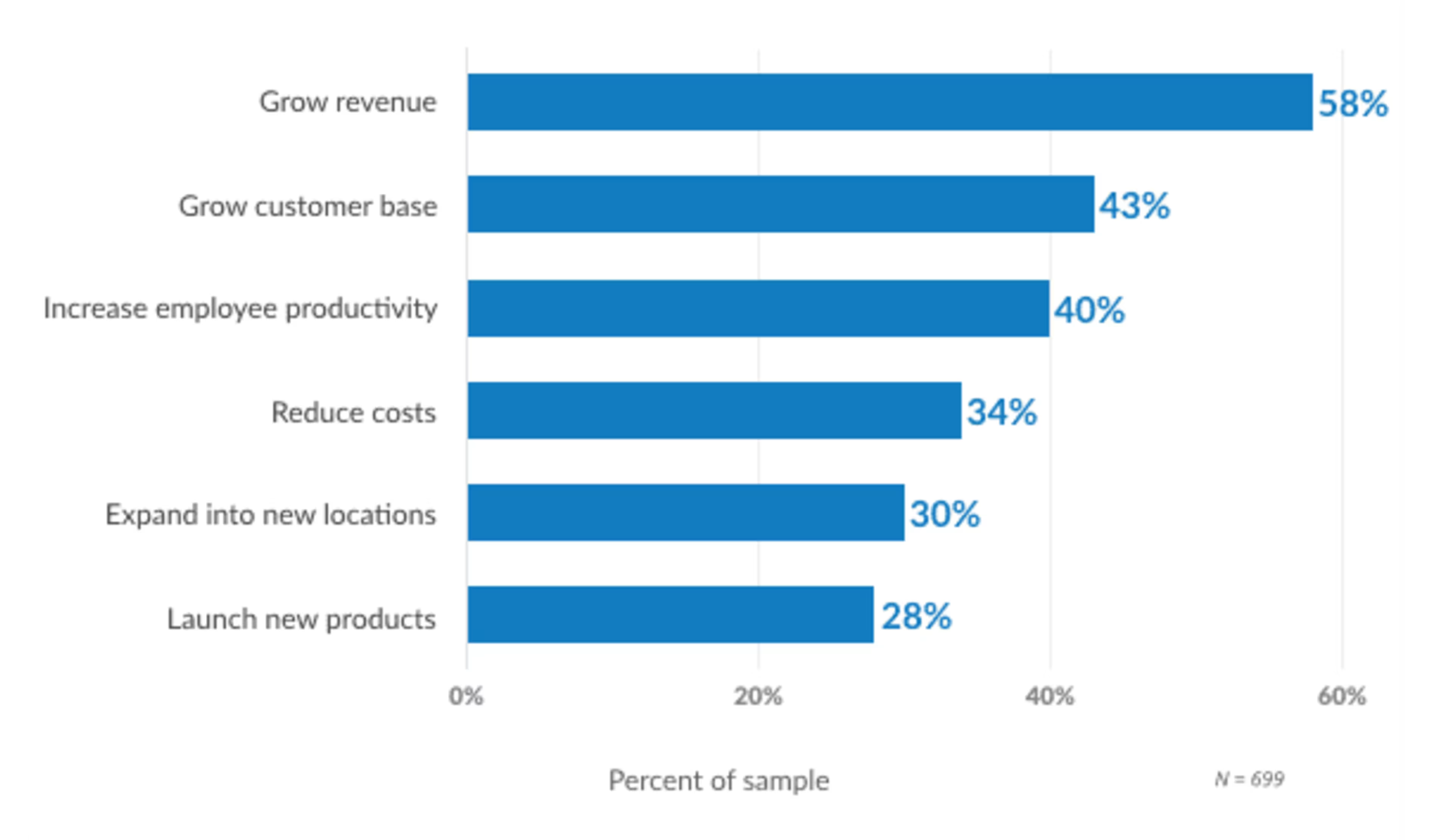
SMB Business Goals: 2017 - 2019
We also see, however, that efforts to improve employee effectiveness show up as both a top goal (40% want to increase employee productivity) and as a major theme among the challenges businesses face in striving to achieve their goals.
In fact, concerns regarding how to best optimize employee effectiveness dominate responses when we ask SMBs about their biggest challenges:
Using the right technology: 21%
Hiring the right people: 20%
Motivating and retaining staff: 16%
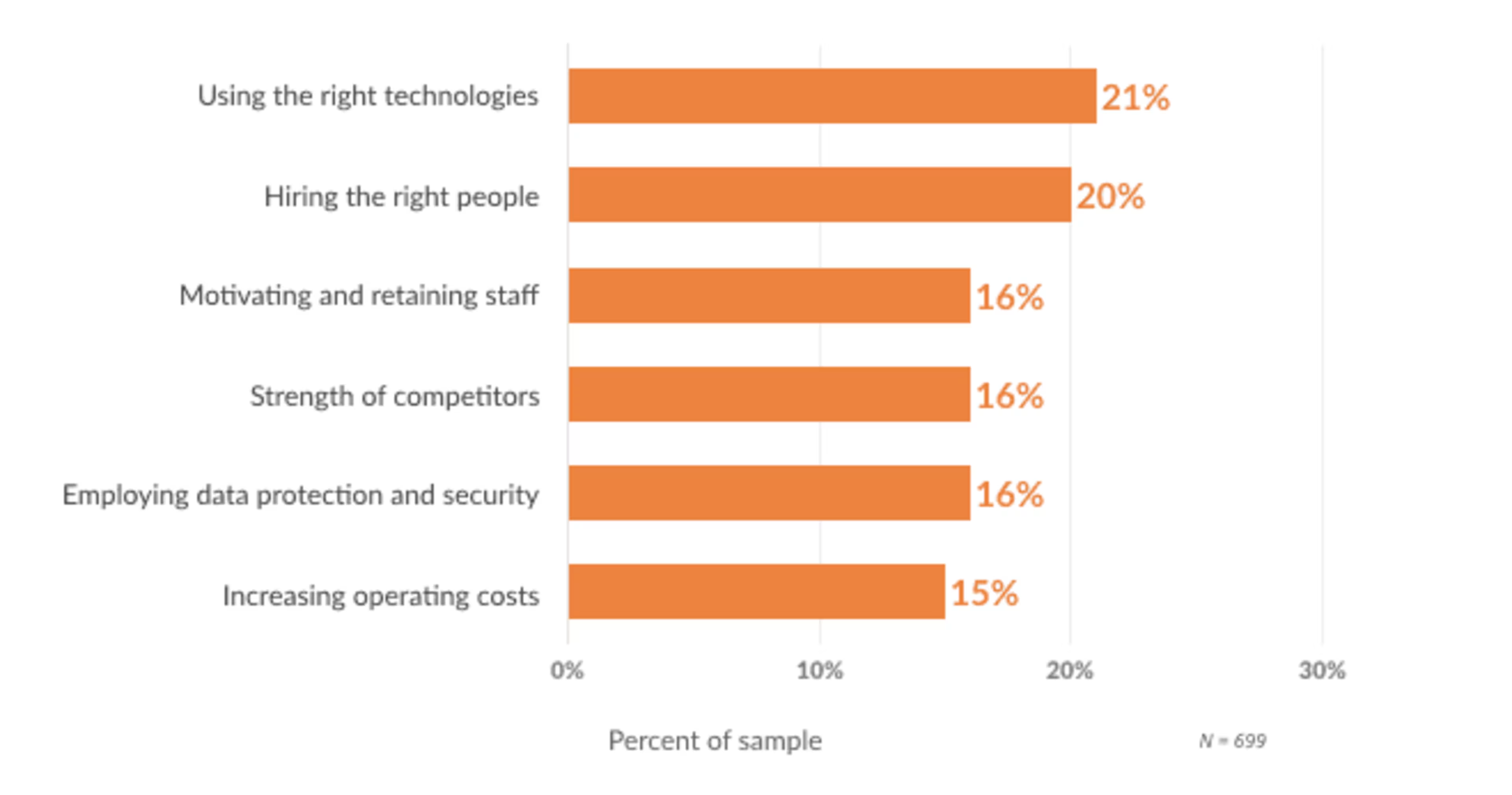
Top Challenges to Achieving Business Goals
These challenges exceed other important considerations, such as competitive pressure and the cost of operations.
This tells us that improving effectiveness is paramount for SMBs to achieve growth objectives.
Creating an effective, high-functioning workplace allows businesses to increase their output without increasing input by the same amount. Meaning that, by making employees more efficient, they can achieve growth without increasing the number of people employed or the number of hours worked.
Which industries face the biggest hurdle in trying to improve effectiveness?
SMBs in construction, manufacturing, and services industries are most concerned with hiring and maintaining a productive workforce.
Challenges stemming from trying to create and maintain a high-functioning workplace aren't exclusive to any one market or business size; however, some industries are feeling these pains more acutely than others.
When we break the "Top Challenges to Achieving Business Goals" down by industry, trade-based industries report the greatest challenges with hiring and retaining workers.
An average of 23% of business leaders in these industries say “hiring the right people" is the single biggest impediment to achieving their growth objectives:
IT Services and software: 24%
Manufacturing: 22%
Construction: 22%
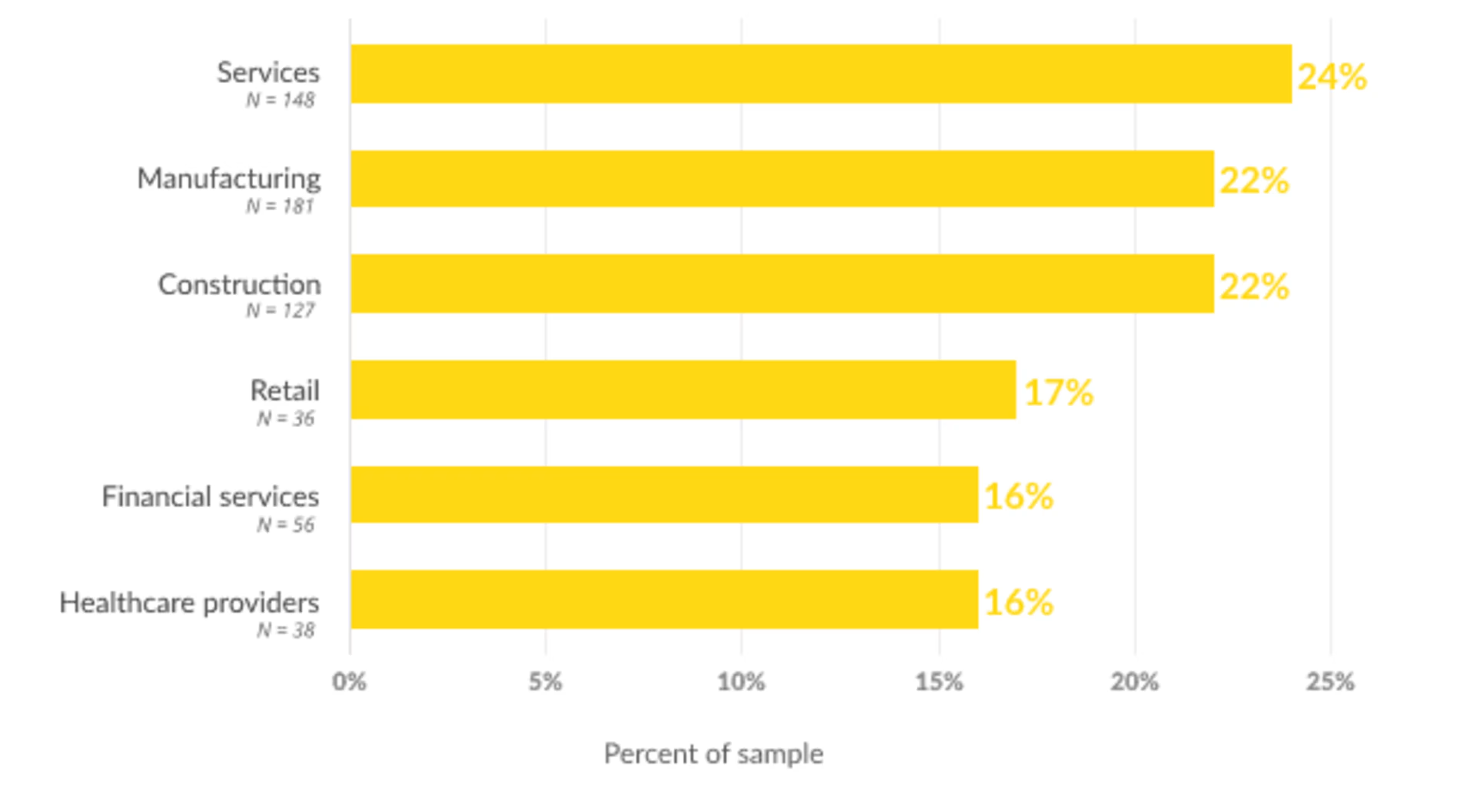
Hiring as Top Challenge to Achieving Business Goals: By Industry
Similarly, an average of 18% of business leaders in these same industries say “motivating and retaining staff" is their single most critical issue:
Manufacturing: 22%
Construction: 18%
IT Services and software: 14%
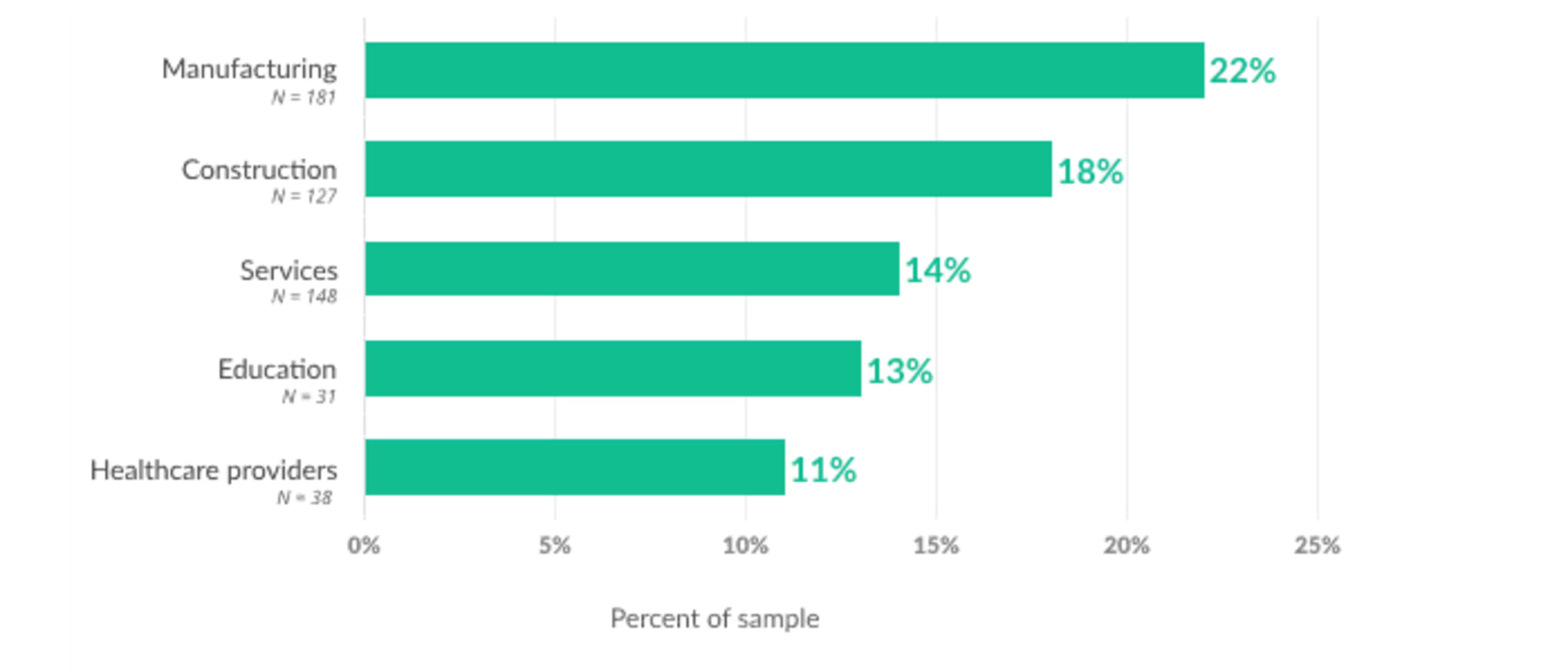
Motivating and Retaining Employees as Top Challenge to Achieving Business Goals: By Industry
Combined, that means that nearly half of these industries are struggling to find, hire, and retain workers.
What's going on? SMBs in construction, services, and manufacturing—and other trade-based industries—have the toughest hill to climb because of the skilled labor shortage (see chart below).
Companies are struggling to attract new people to fill vacancies, retain them, and grow them into critical line and management roles—because people themselves are limited.
According to the Bureau of Labor Statistics (BLS), productivity declined in 54 of 90 manufacturing and mining segments in 2017, as companies tried to combat the shortage by increasing worker hours, but suffered decreased output as a result.
In a Software Advice study, where they've had to turn down jobs because there's more work than they can staff, or delay/stall jobs until workers become available.
Simply stated, demand is high, but worker supply is low. Older workers are retiring and there are fewer new and/or young workers choosing a trade-based career path who have the skills to take their place. This is causing a “war for talent" as these industries are forced to fish from the same, dwindling pool of talent.
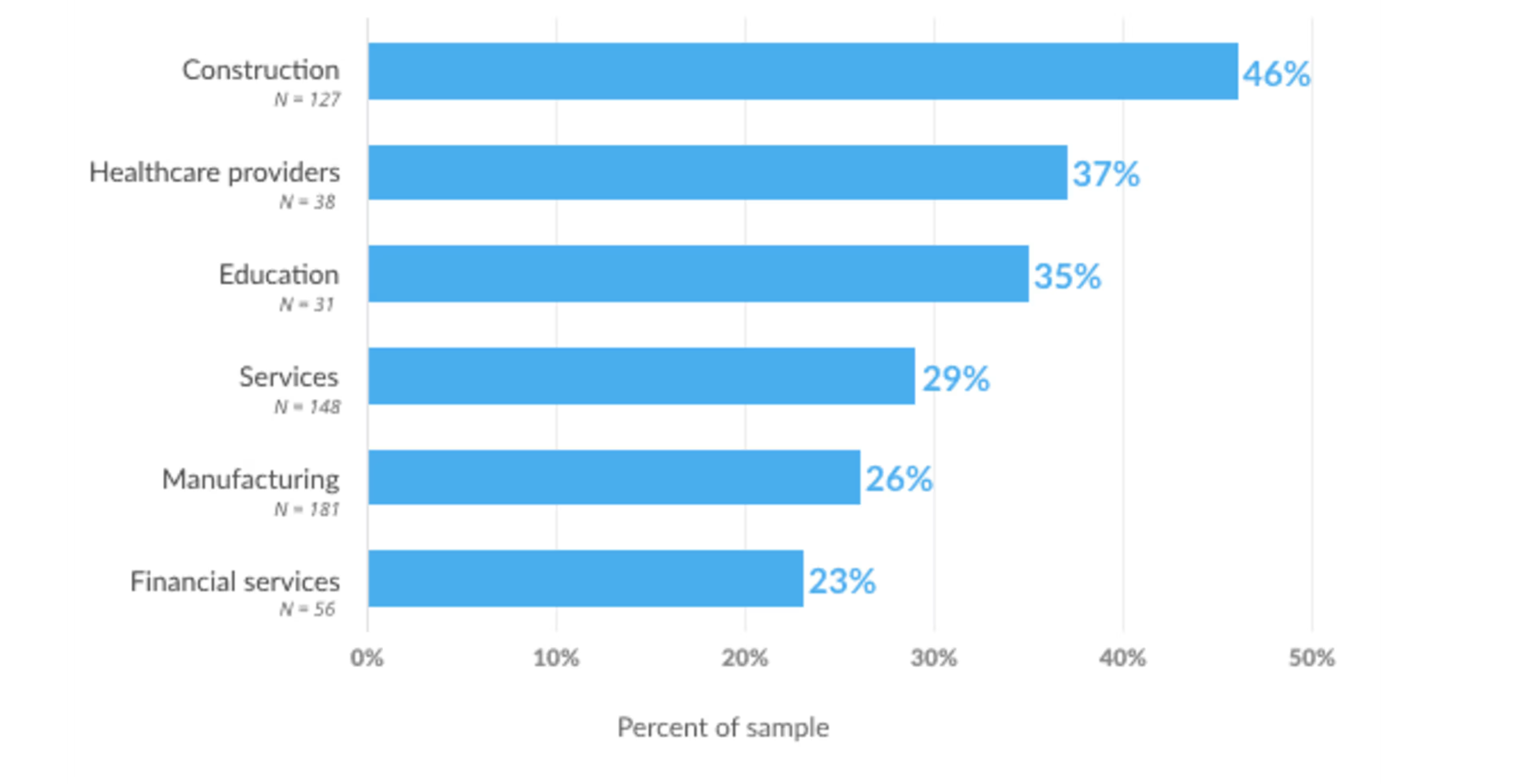
Skills Availability as an External Factor Shaping Business Goals: By Industry
What impact will gains and losses in effectiveness have on the marketplace?
Businesses that succeed at improving employee effectiveness will grow at the expense of those who don't. They will gain a competitive edge and prominence in the marketplace.
With changing demographics, rapidly advancing business technologies, and an ever evolving business climate, we expect that building and retaining a highly effective workforce will continue to accelerate as a significant challenge to business growth.
The war for talent will have major ramifications—not just on construction, utilities, and manufacturing industries (and their consumers), but on every business regardless of size:
Employers should expect to pay higher salaries, improve benefits packages, and increase investments in skills training and succession planning.
Consumers should expect higher project costs, increased timelines and delays, reduced quality, and a higher potential for rework.
Furthermore, the challenges these SMBs face (skills availability, finding and hiring the right workers, then retaining them in increasingly cutthroat and competitive fields all while dealing with limited resources), means that improving labor productivity is more important than ever.
Consider this: A McKinsey study found that high performers are 400% more productive than average ones, and as occupations become more complex (e.g., managers, skill-based trades, information and interaction intensive work, etc.) high performers are up to 800% more productive.
If, for example, you have a project expected to achieve results in three years and you replace a fifth of your average workforce with talent 400% more productive, your timeline would drop to two years. If they were 800% more productive, it would take less than one.
This study shows that if you replace average workers with high performers, you can achieve your desired results much more quickly. But by the same logic, so can your competitors.
The old adage that, "you are only as good as your people" is more true today than ever before.
Companies that start today to create a culture of performance—by focusing on internal process improvements, by investing in the right technology to make existing workers more efficient, and by cultivating critical line and management roles—will pull ahead of those who hesitate.
How can SMBs improve employee effectiveness?
Take stock of your current levels of productivity, set goals for improvement, then continuously strive for "process with a purpose."
There are many avenues to building a high-functioning workforce, including creating the right roles, attracting the right talent, providing the right tools, building strong leadership, and creating "process with a purpose."
We have found that the most important is “process with a purpose." This means creating an organization with a predominant mindset of continuous positive change, where you question the status quo that exists because "we've always done it this way," and instead enact processes that optimize, not hinder, performance. (See part two for our "process with a purpose" strategic roadmap.)
Of course, before you can improve upon something, you first have to take stock of where you are in relation to where you want to be. As such, small businesses need to first reflect on and analyze their current degree of effectiveness:
How productive are your employees? Survey them and ask for candid feedback about the biggest drains on their productivity, then take corrective action. Hint: Over 60% of an employee's time is spent on non role-specific tasks such as answering email and searching for and gathering information. The right tools in these areas can result in productivity gains of 20 to 25%.
Are employees overworked or underutilized? The sweet spot for productivity is between 70 and 80% utilization—exceed that and performance plummets. Use our calculator and find out what 80% utilization looks like for resources at your SMB.
Do you have the right people in the right roles? Succession planning helps you find the future leaders of your company and give them the training, mentorship, and skills development they need to be ready to fill those roles.
Do employees have the right tools that help increase their output? Think about cutting a field with scissors, versus a push mower, versus a riding mower. They all get the job done, but the right tool enables the individual to do more work in less time and with far less effort.
Figure out where you are strong and where you need to improve.
Recommendations
Once you've benchmarked your current output, you can institute "process with a purpose" to help drive continuous positive change.
There are some critical elements that go hand-in-hand with a culture focused on "process with a purpose," so we offer the following recommendations:
Foster a leadership culture that promotes accidental project managers who can drive operational change.
Create a workplace that is conducive to employee effectiveness in that it empowers and enables employees to be their best.
Understand key stakeholders and what success means to them to ensure that your employees are focused on doing the right things.
Build a leadership team that knows when it is time to change, what is the right type and amount of change and how to motivate people through that change.